Tribological and Emission Behavior of Novel Friction Materials
Abstract
1. Introduction
- Airborne brake emissions can be defined as the result of wear debris released with aerodynamic diameter lower than 10 µm by the tribological system. Some studies [19,20] proposed that a range of 35% to 55% of the total brake system wear becomes airborne particles. Garg et al. [21] estimated that almost 35% of brake pad mass loss is emitted as airborne particles.
- Several parameters could affect the emissions, aside from the friction material composition itself, with braking pressure, sliding velocity and temperature (which is strongly dependent on the aforementioned parameters) being reported as the most important ones, also as the tribological properties are concerned. Alemani et al. [10] identified a critical temperature between 165 °C and 190 °C, characterized by a significant increase in number of emitted ultrafine particles, while the coarse ones decrease. Nosko et al. [22] pointed out that the ultrafine emitted particles above 200 °C rises by several tens of percentages in terms of mass. Kukutschova et al. [23] suggested that the increase in the ultrafine fraction is linked to the degradation and burning-off of the phenolic resin, featuring a typical ignition temperature of about 300 °C. Based on the chemical composition of the emissions, several studies [8,24,25,26] demonstrated that airborne particles, originating from both pads and disc materials, including iron, come from the cast iron disc, and contribute to around 60% of the total mass emitted, for low-metallic brake systems [27]. Mosleh et al. [28] proposed that fine particles come exclusively from the disc, whereas the coarse ones originate from the friction material. On the other hand, Wahlström et al. [29] pin-on-disc (PoD) tested low-metallic and NAO braking pads and found Fe, Cu, Ti, Al, O and carbonaceous species as the main constituents of fine emissions, indicating the contribution of the friction materials. Alemani et al. [25] showed that disruption of the friction layer leads to the emission of particles characterized by a flake-like morphology. Previous studies [30,31] demonstrated a chemical composition correspondence between friction layer and emissions, also showing the contribution of the disc. However, all mechanisms involved in the generation of emission are not fully understood as of yet.
- Three testing set-ups are mainly used for friction materials, depending on the testing scale: full-scale car brake systems, dynamometric benches and laboratory-scale pin-on-disc (PoD) tribometers. PoD testing has been proven to be a fast and valuable method of assessing friction material properties, in particular when looking at comparative results [32]. Different investigations [12,33,34] have demonstrated that useful information regarding the emission behavior and its correlation with tribological properties come up from pin-on-disc laboratory tests. The obtainment, on a lab-scale level, of reliable relationships among the identified wear mechanism and the relevant airborne particle emissions would be extremely important in order to increase the efficiency and quality of brake material development.
- The present work aims at investigating the tribological behavior and the related emissions from three commercial Cu-free friction materials using pin-on-disc tribological testing. We focused our attention on the friction layer characterization and its connection with the tribological and emissions results. A thorough comparison among the chemical composition of bulk material, secondary plateau and emissions is presented, as well as their relationships. Moreover, the composition of the secondary plateaus is analyzed at two different depths.
2. Experimental Methodology
2.1. Materials
2.2. Pin-on-Disc Tests and Emissions Measurements
2.3. Characterization Procedures
3. Results
3.1. Friction and Wear Behavior
3.2. Airborne Particles Emissions
3.3. Characterization of the Friction Layer and Emitted Particles
4. Discussion
5. Conclusions
- The material Cu-free/Fe yields the higher friction coefficient and lower wear coefficient in comparison to the other two materials. Both results are linked to the higher amount of iron oxide present in the secondary plateaus, favoring the friction performance by the iron oxide contact with the cast iron counterface disc, thus decreasing the wear by the formation of more compact secondary plateau.
- The emissions produced by Cu-free/A friction material contain more metallic iron than its secondary plateaus. This indicates that the airborne particles are made not only by the disruption of the secondary plateaus but also by the cast iron counterface wear, exerted by the abrasives present in this friction material. For the other two friction materials, Cu-free/Ba and Cu-free/Fe, the airborne particles seem to be mainly formed by the disruption of friction layer, since both materials present a clear correspondence between the chemical composition of the emissions and the secondary plateaus.
- The material Cu-free/Ba exhibits a higher wear coefficient and lower emissions with respect to the other tested materials. The absence of correlation between the wear and emissions is associated to the disruption of friction layer in relatively large fragments caused by the not well compacted secondary plateau.
Author Contributions
Funding
Acknowledgments
Conflicts of Interest
References
- Straffelini, G.; Ciudin, R.; Ciotti, A.; Gialanella, S. Review: Present knowledge and perspectives on the role of copper in brake materials and related environmental issues: A critical assessment. Environ. Pollut. 2015, 207, 211–219. [Google Scholar] [CrossRef]
- Kumar, M.; Bijwe, J. Non-asbestos organic (NAO) friction composites: Role of copper; its shape and amount. Wear 2011, 270, 269–280. [Google Scholar] [CrossRef]
- Lee, P.W.; Filip, P. Friction and wear of Cu-free and Sb-free environmental friendly automotive brake materials. Wear 2013, 302, 1404–1413. [Google Scholar] [CrossRef]
- Balakrishna, S.; Lomnicki, S.; McAvey, K.M.; Cole, R.B.; Dellinger, B.; Cormier, S.A. Environmentally persistent free radicals amplify ultrafine particle mediated cellular oxidative stress and cytotoxicity. Part. Fibre Toxicol. 2009, 6, 11–24. [Google Scholar] [CrossRef] [PubMed]
- Peikertová, P.; Kukutschová, J.; Vávra, I.; Matějka, V.; Životsky, O.; Vaculik, M.; Lee, P.W.; Filip, P. Water suspended nanosized particles released from nonairborne brake wear debris. Wear 2013, 306, 89–96. [Google Scholar] [CrossRef]
- Samet, J.M.; Dominici, F.; Curriero, F.C.; Coursac, I.; Zeger, S.L. Fine Particulate Air Pollution and Mortality in 20 U.S. Cities. N. Engl. J. Med. 2001, 344, 1253–1254. [Google Scholar]
- Pope, C.A., III. Lung Cancer, Cardiopulmonary Mortality, and Long-term Exposure to Fine Particulate Air Pollution. JAMA 2002, 287, 1132–1141. [Google Scholar] [CrossRef]
- Kukutschová, J.; Roubiček, V.; Malachová, K.; Pavličková, Z.; Holuša, R.; Kubačková, J.; Mička, V.; MacCrimmon, D.; Filip, P. Wear mechanism in automotive brake materials, wear debris and its potential environmental impact. Wear 2009, 267, 807–817. [Google Scholar] [CrossRef]
- Xing, Y.F.; Xu, Y.H.; Shi, M.H.; Lian, Y.X. The impact of PM2.5 on the human respiratory system. J. Thorac. Dis. 2016, 8, E69–E74. [Google Scholar]
- Alemani, M.; Nosko, O.; Metinoz, I.; Olofsson, U. A study on emission of airborne wear particles from car brake friction pairs. SAE Int. J. Mater. Manuf. 2016, 9, 147–157. [Google Scholar] [CrossRef]
- Wahlström, J. A Study of Airborne Wear Particles from Automotive Disc Brakes. Ph.D. Thesis, KTH Royal Institute of Technology, Stockholm, Sweden, 2011. [Google Scholar]
- Lyu, Y.; Leonardi, M.; Wahlström, J.; Gialanella, S.; Olofsson, U. Friction, wear and airborne particle emission from Cu-free brake materials. Tribol. Int. 2020, 141, 105959–105965. [Google Scholar] [CrossRef]
- Barros, L.; Poletto, J.; Neis, P.; Ferreira, N.F.; Pereira, C. Influence of copper on automotive brake performance. Wear 2019, 426–427, 741–749. [Google Scholar] [CrossRef]
- Menapace, C.; Leonardi, M.; Matějka, V.; Gialanella, S.; Straffelini, G. Dry sliding behavior and friction layer formation in copper-free barite containing friction materials. Wear 2018, 398–399, 191–200. [Google Scholar] [CrossRef]
- Aranganathan, N.; Bijwe, J. Comparative performance evaluation of NAO friction materials containing natural graphite and thermo-graphite. Wear 2016, 358, 17–22. [Google Scholar] [CrossRef]
- Eriksson, M.; Jacobson, S. Tribological surfaces of organic brake pads. Tribol. Int. 2000, 33, 817–827. [Google Scholar] [CrossRef]
- Eriksson, M.; Bergman, F.; Jacobson, S. On the nature of tribological contact in automotive brakes. Wear 2002, 252, 26–36. [Google Scholar] [CrossRef]
- Leonardi, M.; Menapace, C.; Matějka, V.; Gialanella, S.; Straffelini, G. Pin-on-disc investigation on copper-free friction materials dry sliding against cast iron. Tribol. Int. 2018, 119, 73–81. [Google Scholar] [CrossRef]
- Menapace, C.; Mancini, A.; Federici, M.; Straffelini, G.; Gialanella, S. Characterization of airborne wear debris produced by brake pads pressed against HVOF-coated discs. Friction 2019, 1–12. [Google Scholar] [CrossRef]
- Harrison, R.M.; Jones, A.M.; Gietl, J.; Yin, J.; Green, D.C. Estimation of the Contributions of Brake Dust, Tire Wear, and Resuspension to Nonexhaust Traffic Particles Derived from Atmospheric Measurements. Environ. Sci. Technol. 2012, 46, 6523–6529. [Google Scholar] [CrossRef]
- Garg, B.D.; Cadle, S.H.; Mulawa, P.A.; Groblicki, P.J.; Laroo, C.; Parr, G.A. Brake Wear Particulate Matter Emissions. Environ. Sci. Technol. 2000, 34, 4463–4469. [Google Scholar] [CrossRef]
- Nosko, O.; Olofsson, U. Quantification of ultrafine airborne particulate matter generated by the wear of car brake materials. Wear 2017, 374–375, 92–96. [Google Scholar] [CrossRef]
- Kukutschová, J.; Moravec, P.; Tomásek, V.; Matejka, V.; Smolík, J.; Schwarz, J.; Seidlerová, J.; Safárová, K.; Filip, P. On airborne nano/micro-sized wear particles released from low-metallic automotive brakes. Environ. Pollut. 2011, 159, 998–1006. [Google Scholar] [CrossRef] [PubMed]
- Roubicek, V.; Raclavska, H.; Juchelkova, D.; Filip, P. Wear and environmental aspects of composite materials for automotive braking industry. Wear 2008, 265, 167–175. [Google Scholar] [CrossRef]
- Alemani, M.; Gialanella, S.; Straffelini, G.; Ciudin, R.; Olofsson, U.; Perricone, G.; Metinoz, I. Dry sliding of a low steel friction material against cast iron at different loads: Characterization of the friction layer and wear debris. Wear 2017, 376–377, 1450–1459. [Google Scholar] [CrossRef]
- Perricone, G.; Matejka, V.; Alemani, M.; Valota, G.; Bonfanti, A.; Ciotti, A.; Olofsson, U.; Söderberg, A.; Wahlström, J.; Nosko, O.; et al. A concept for reducing PM10 emissions for car brakes by 50%. Wear 2018, 396–397, 135–145. [Google Scholar] [CrossRef]
- Sanders, P.G.; Xu, N.; Dalka, T.M.; Maricq, M.M. Airborne brake wear debris: Size distributions, composition, and a comparison of dynamometer and vehicle tests. Environ. Sci. Technol. 2003, 37, 4060–4069. [Google Scholar] [CrossRef]
- Mosleh, M.; Blau, P.J.; Dumitrescu, D. Characteristics and morphology of wear particles from laboratory testing of disk brake materials. Wear 2004, 256, 1128–1134. [Google Scholar] [CrossRef]
- Wahlström, J.; Olander, L.; Olofsson, U. Size, shape, and elemental composition of airborne wear particles from disc brake materials. Tribol. Lett. 2010, 38, 15–24. [Google Scholar] [CrossRef]
- Nogueira, A.P.G.; Leonardi, M.; Straffelini, G.; Gialanella, S. Sliding Behavior and Particle Emission of Cu-free Friction Materials with Different Contents of Phenolic Resin. Tribol. Trans. 2020, 1–10. [Google Scholar] [CrossRef]
- Nogueira, A.P.G.; Bagolan, P.; Leonardi, M.; Gialanella, S.; Straffelini, G. The role of scorching treatment on the wear and emission of friction materials with and without copper. Appl. Wear 2020, 460–461, 203480. [Google Scholar] [CrossRef]
- Alemani, M. Particles Emissions from Car Brake: The Influence of Contact Conditions on the Pad-to-Rotor Interface. Ph.D. Thesis, KTH Royal Institute of Technology, Stockholm, Sweden, 2017. [Google Scholar]
- Olofsson, U.; Olander, L.; Jansson, A. A study of airborne wear particles generated from a sliding contact. J. Tribol. 2009, 131, 1–4. [Google Scholar] [CrossRef]
- Wahlström, J.; Lyu, Y.; Matějka, V.; Söderberg, A. A pin-on-disc tribometer study of disc brake contact pairs with respect to wear and airborne particle emissions. Wear 2017, 384, 124–130. [Google Scholar] [CrossRef]
- Archard, J.F. Contact and Rubbing of Flat Surfaces. J. Appl. Phys. 1953, 24, 982–988. [Google Scholar] [CrossRef]
- Archard, J.F. Friction between Metal Surfaces. Wear 1986, 113, 3–16. [Google Scholar] [CrossRef]
- Wei, L.; Choy, Y.S.; Cheung, C.S. A study of brake contact pairs under different friction conditions with respect to characteristics of brake pad surfaces. Tribol. Int. 2019, 138, 99–110. [Google Scholar] [CrossRef]
- Straffelini, G. Friction and Wear Methodologies for Design and Control; Springer: Berlin, Germany, 2015. [Google Scholar]
- Federici, M.; Gialanella, S.; Leonardi, M.; Perricone, G.; Straffelini, G. A preliminary investigation on the use of pin-on-disc test to simulate off-brake friction and wear characteristics of friction materials. Wear 2018, 410–411, 202–209. [Google Scholar] [CrossRef]
- Stott, F. The role of oxidation in the wear of alloys. Tribol. Int. 1998, 31, 61–71. [Google Scholar] [CrossRef]
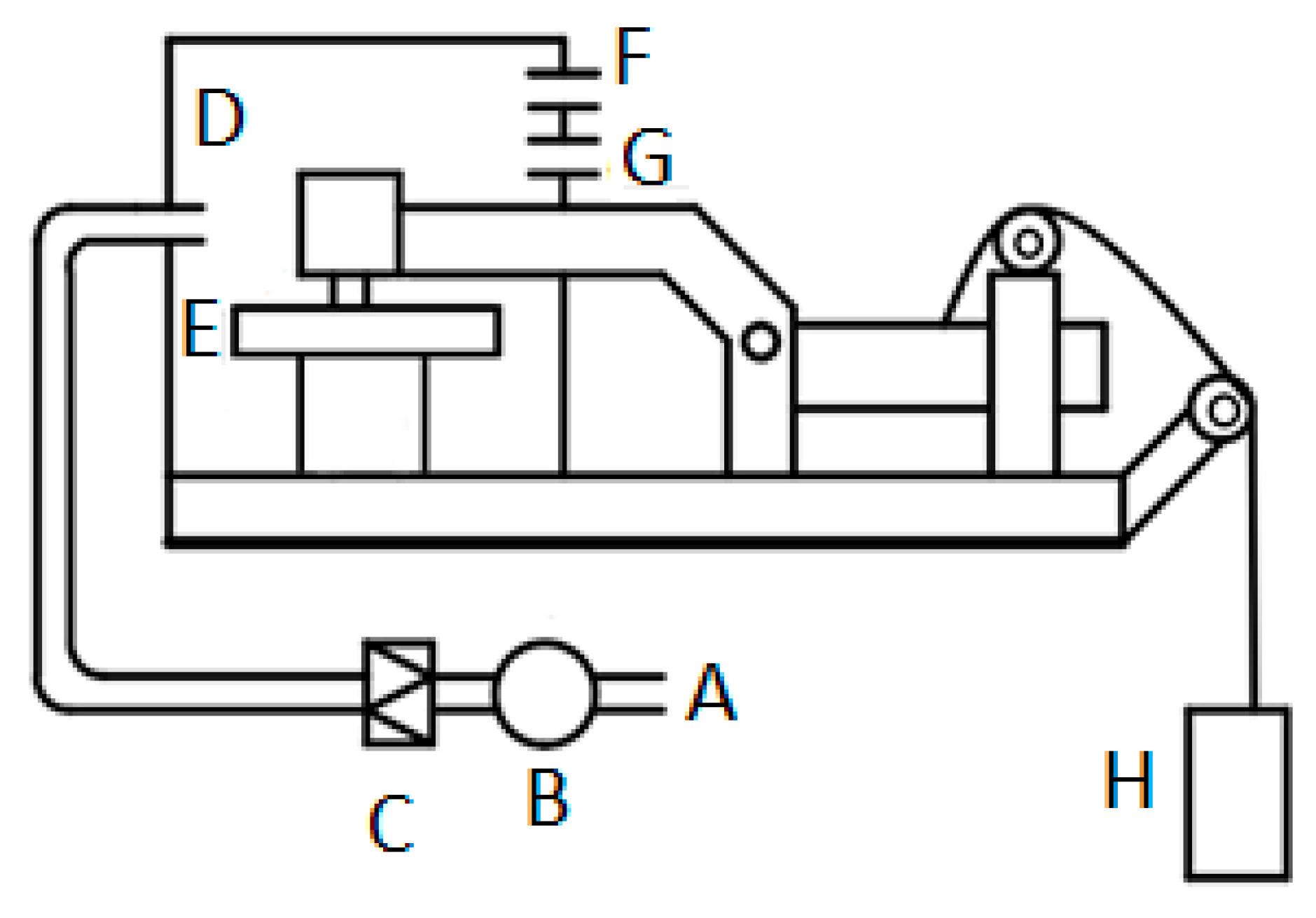
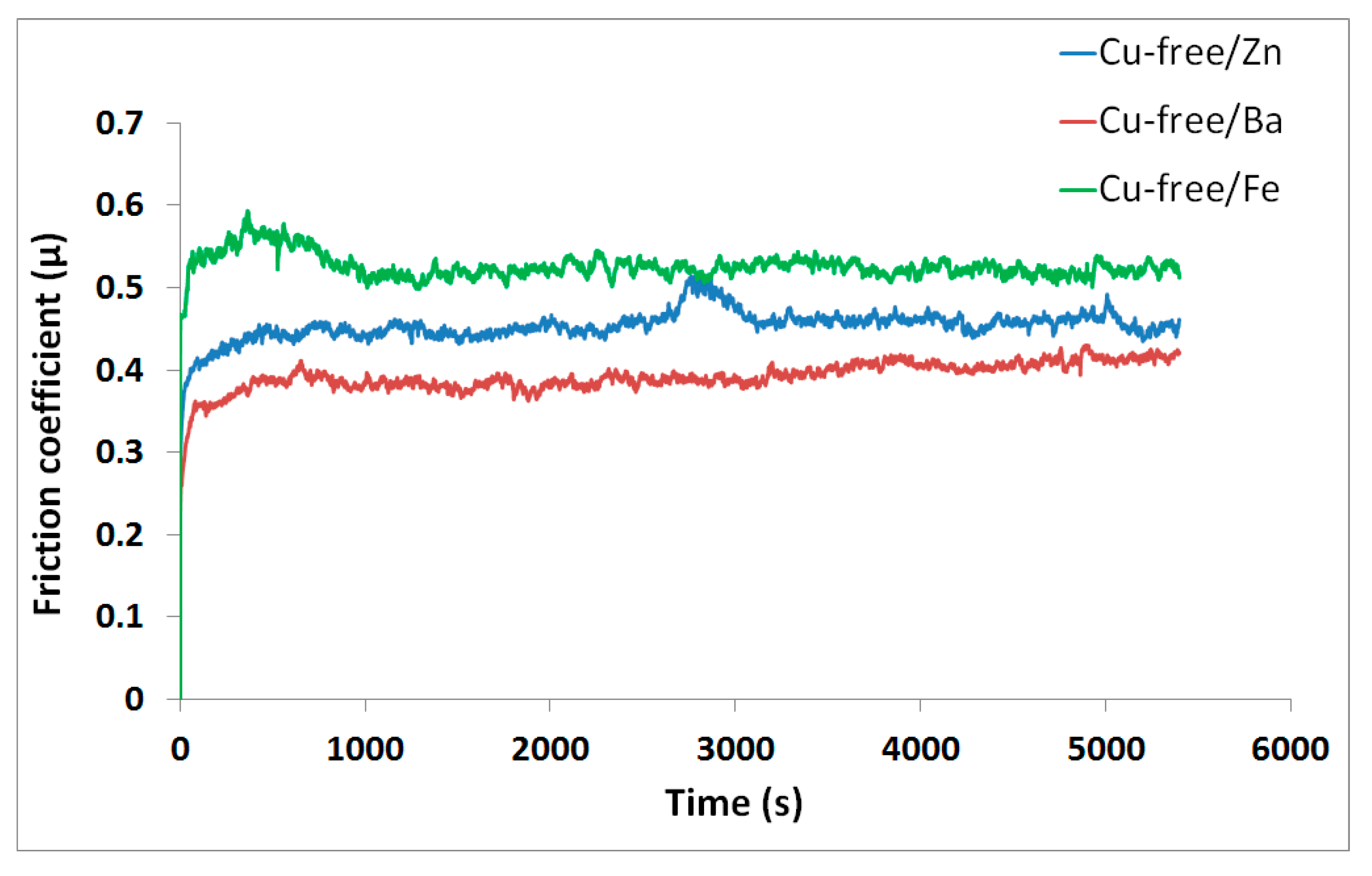

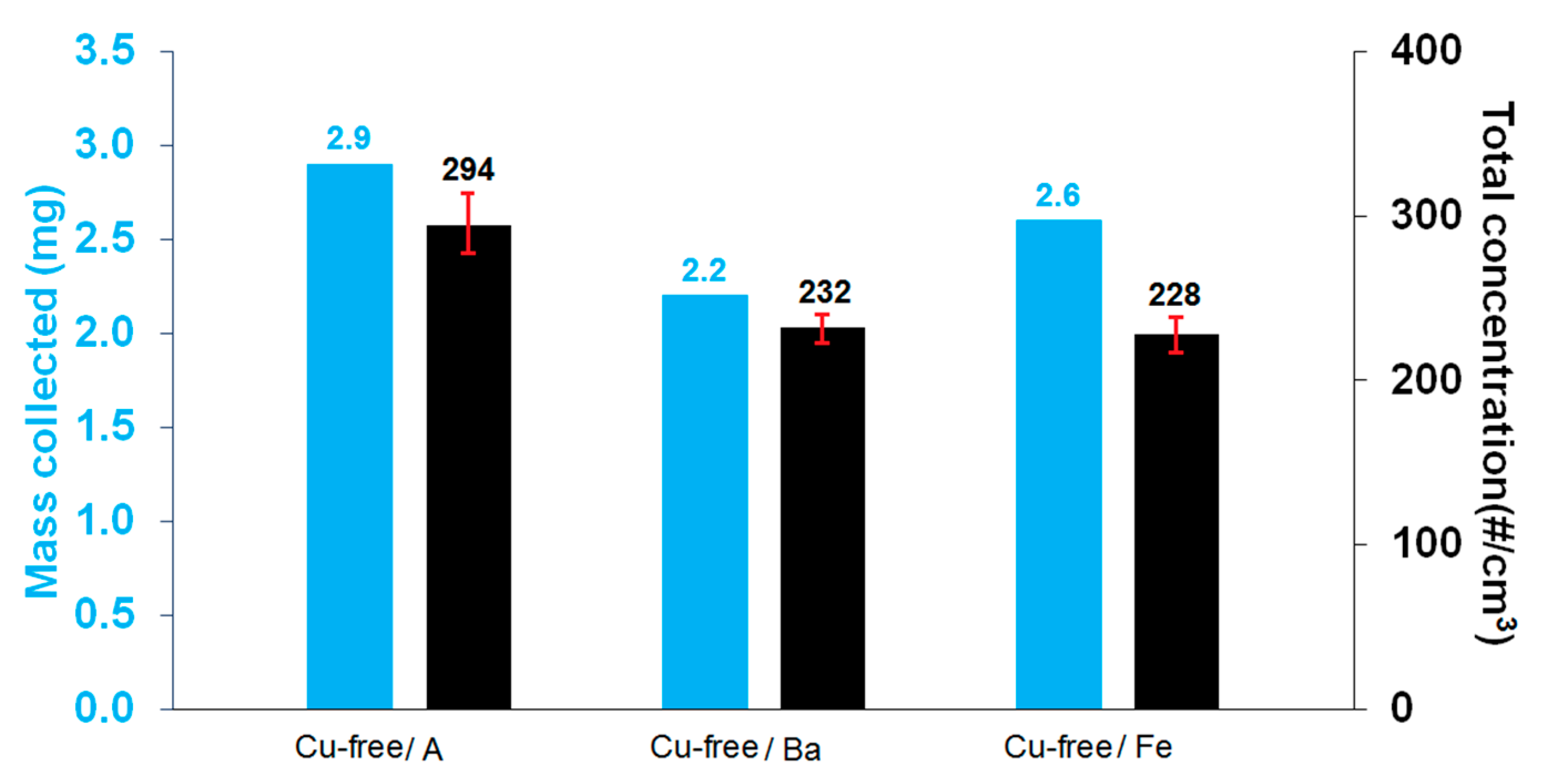
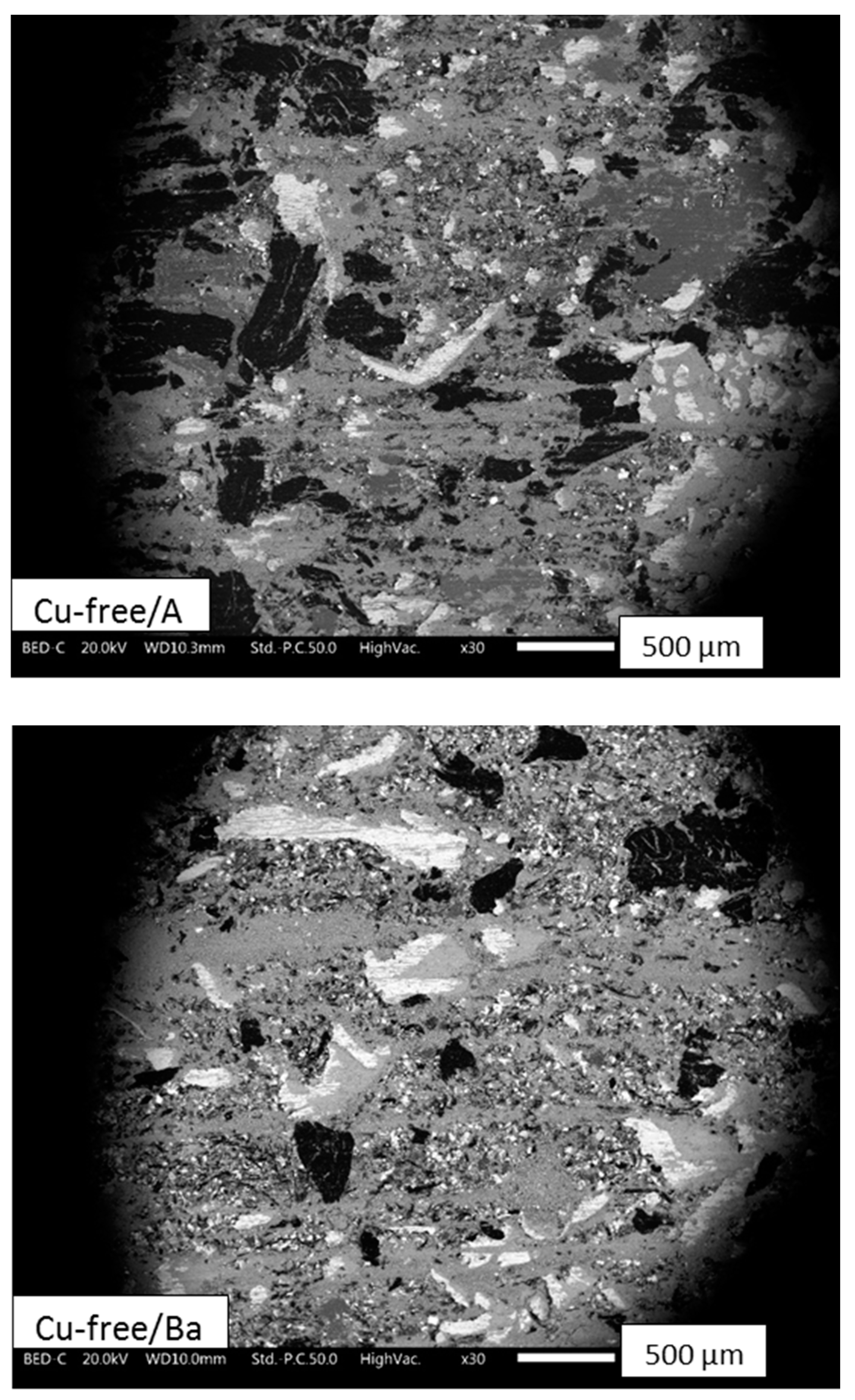
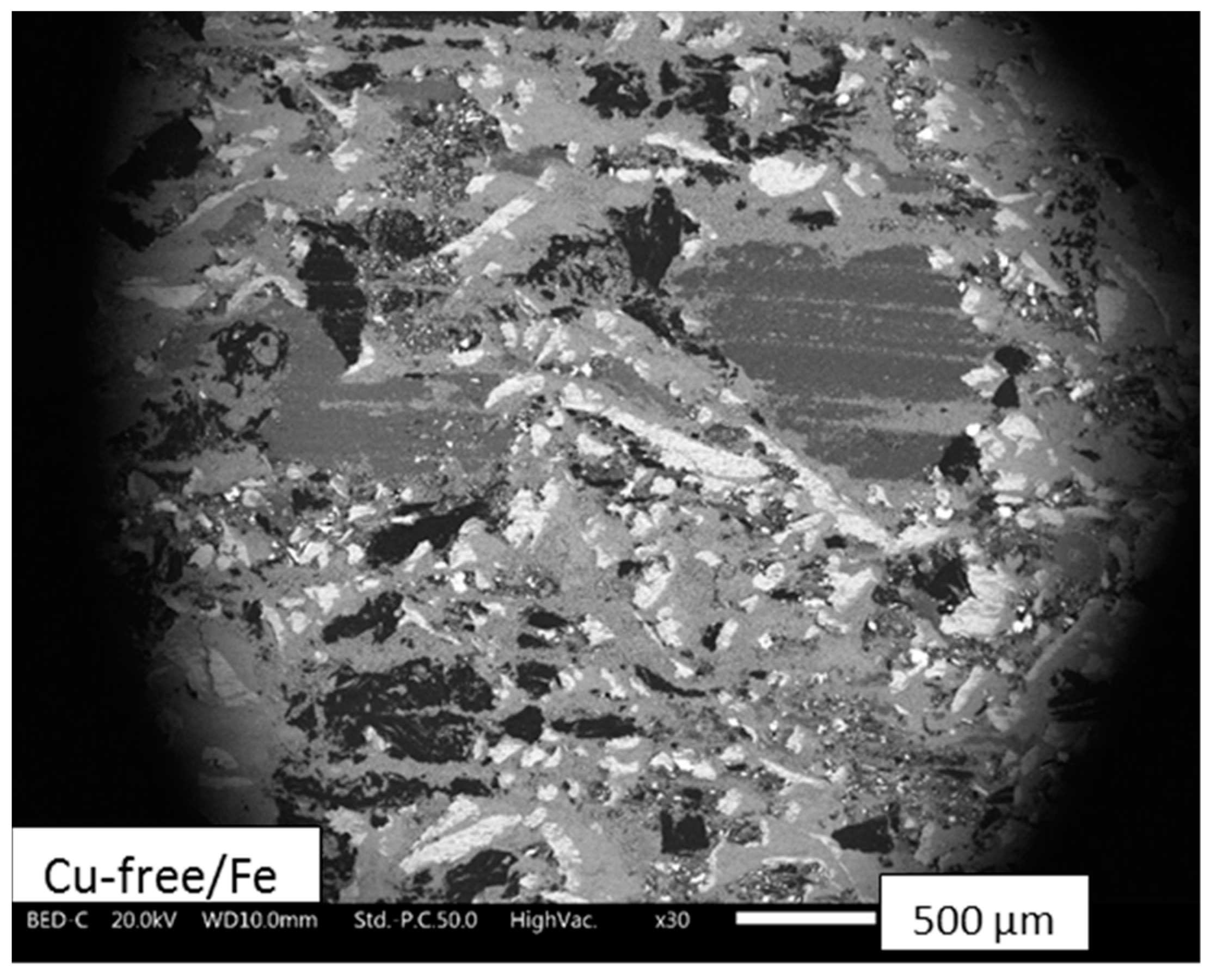
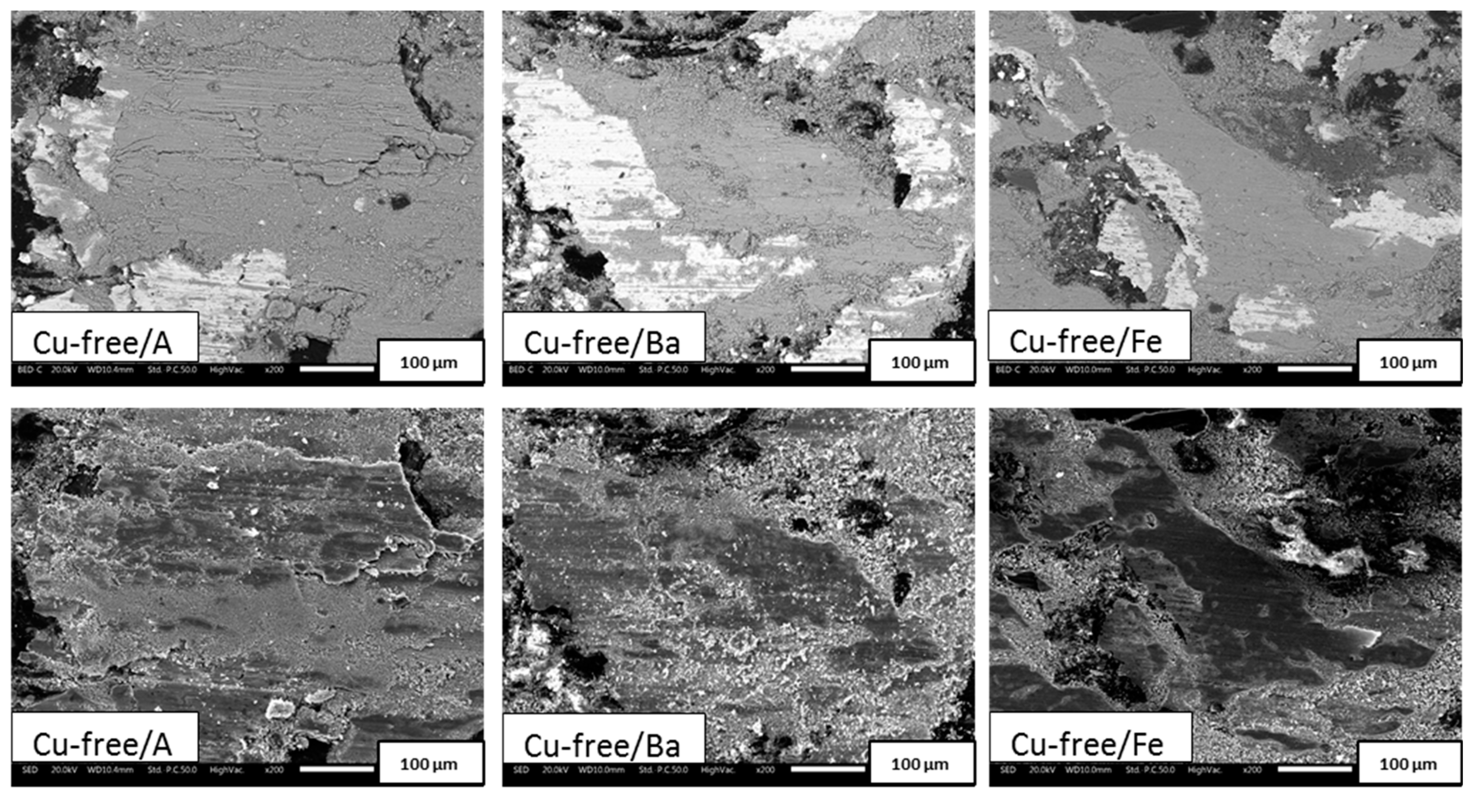
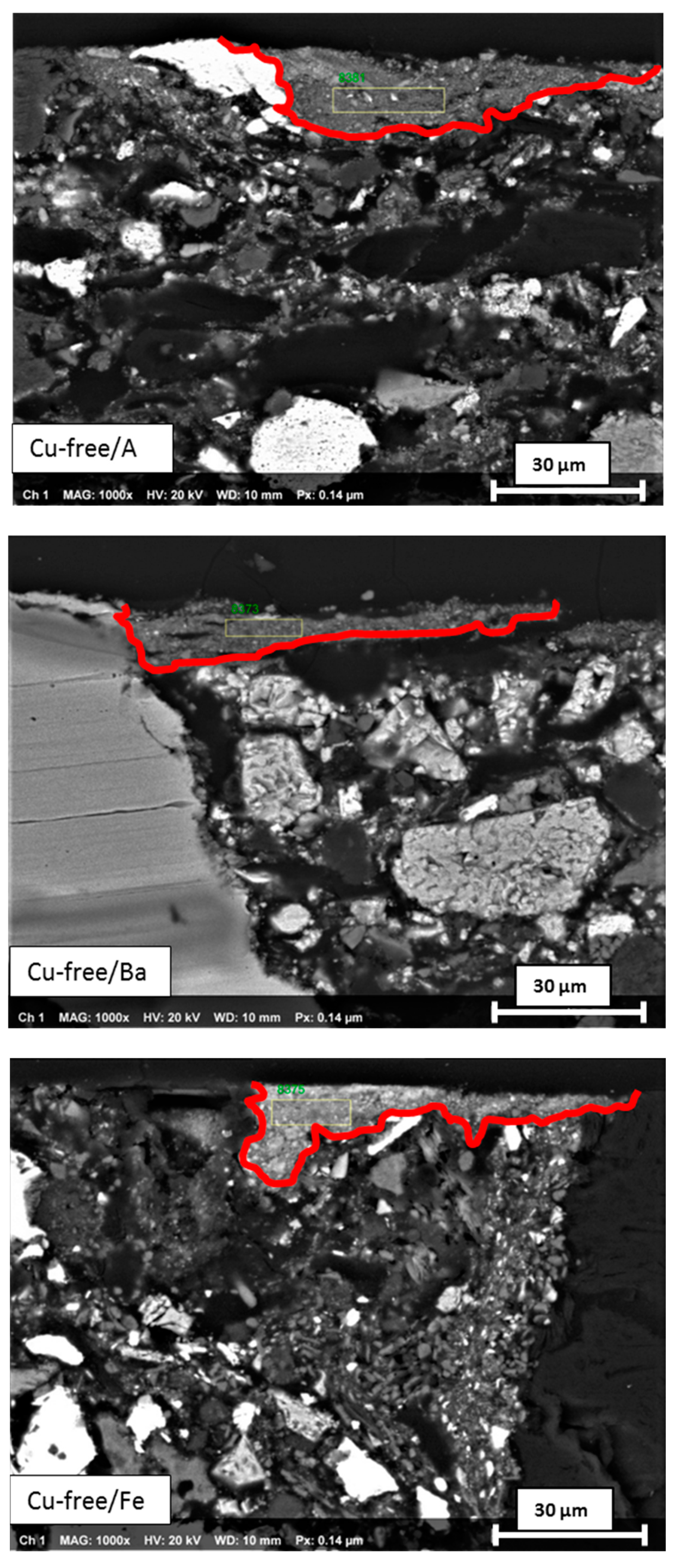

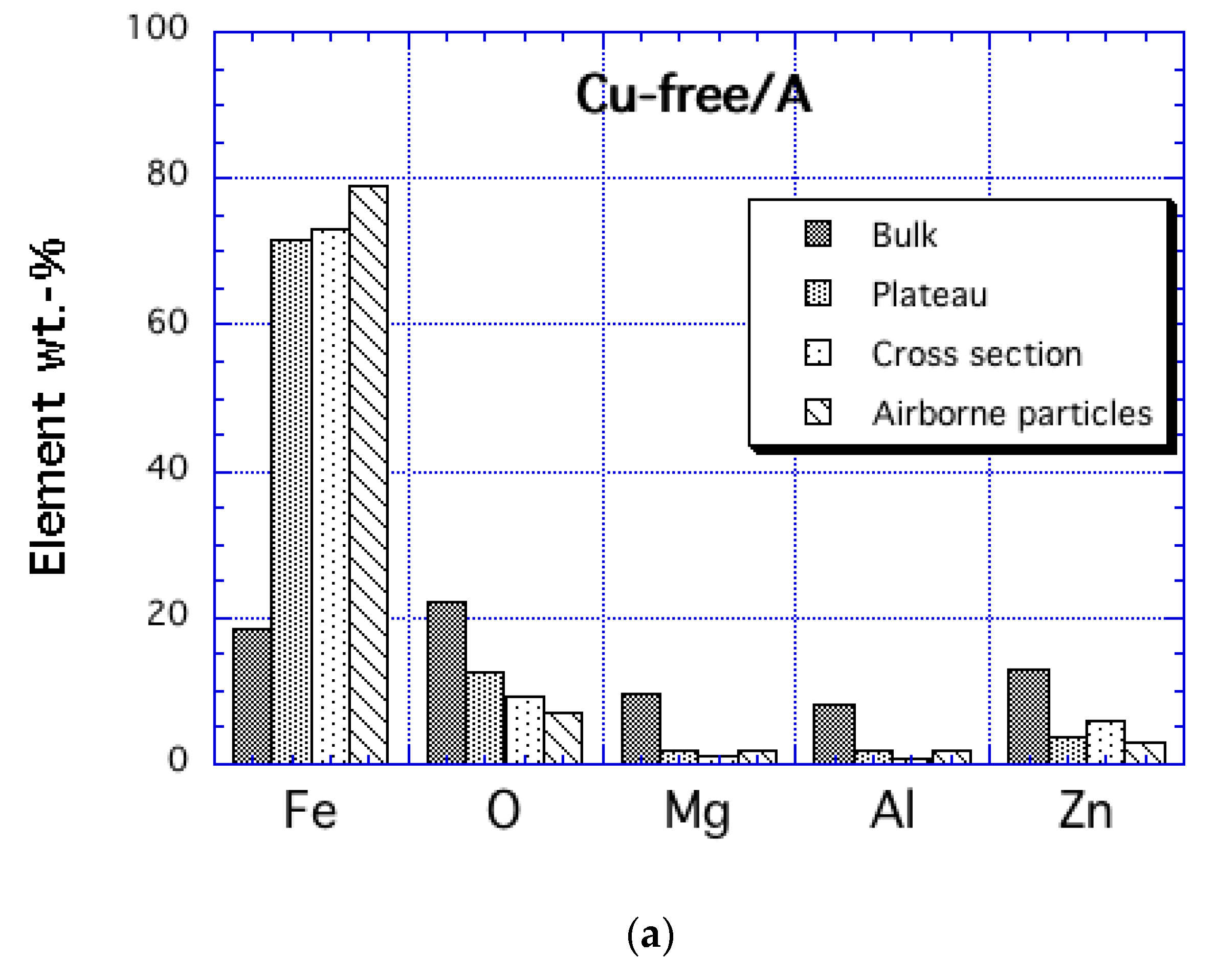
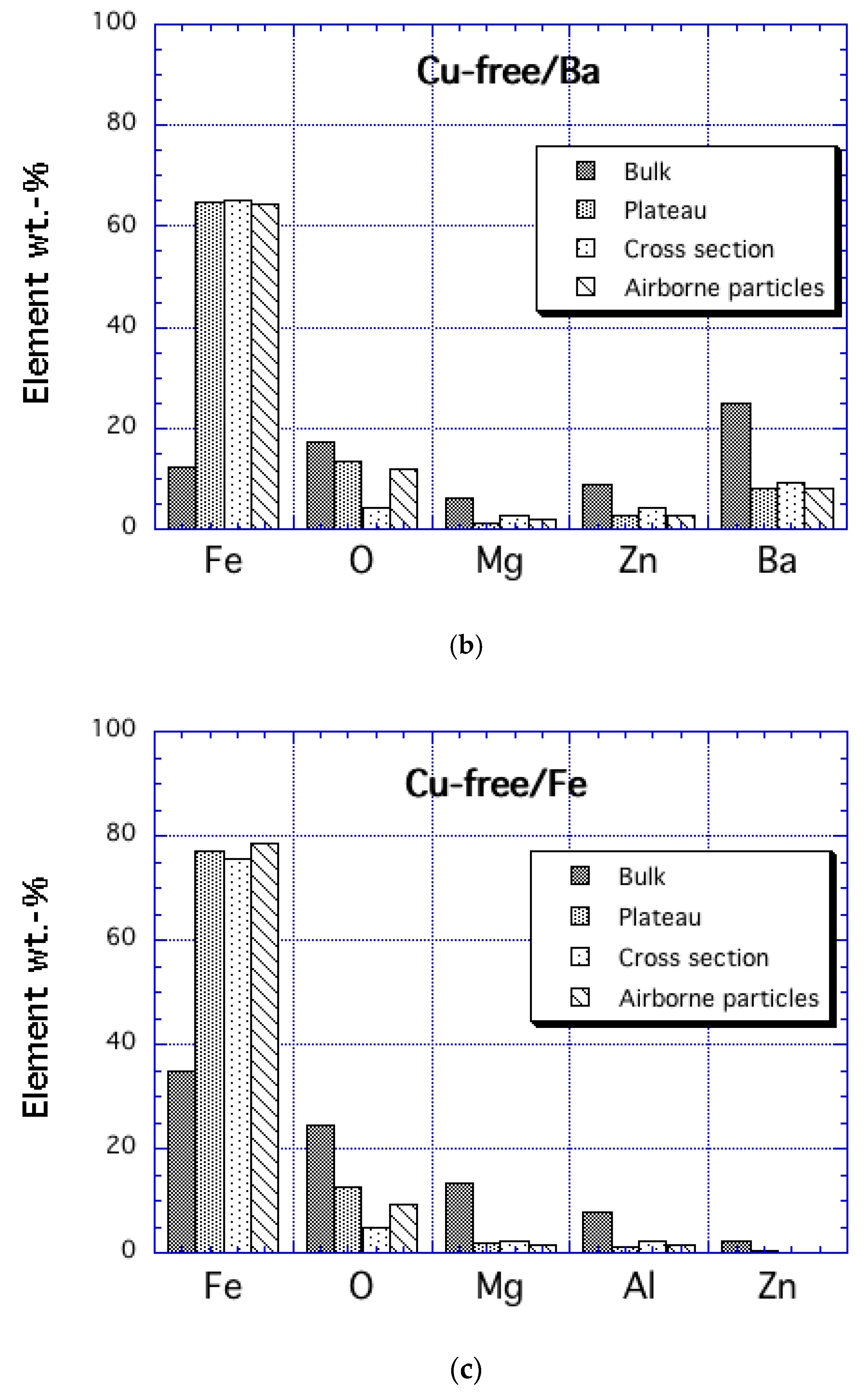
| Element (wt %) | Cu-Free/A | Cu-Free/Ba | Cu-Free/Fe |
|---|---|---|---|
| O | 22.3 ± 1.5 | 17.2 ± 0.5 | 24.4 ± 2.9 |
| Mg | 9.6 ± 0.8 | 6.2 ± 0.1 | 13.2 ± 1.8 |
| Al | 8.2 ± 0.7 | 6.3 ± 0.9 | 7.8 ± 1.3 |
| Si | 3.8 ± 0.6 | 2.8 ± 0.3 | 2.7 ± 0.4 |
| S | 8.7 ± 0.9 | 11.4 ± 0.7 | 5.1 ± 0.5 |
| Ca | 4.0 ± 0.1 | 3.0 ± 0.0 | 1.6 ± 1.1 |
| Cr | 2.5 ± 0.4 | 1.8 ± 0.1 | 2.4 ± 0.2 |
| Mn | 0.0 ± 0.0 | 0.0 ± 0.0 | 0.0 ± 0.0 |
| Fe | 18.6 ± 1.5 | 12.2 ± 2.6 | 34.9 ± 4.9 |
| Zn | 12.8 ± 1.7 | 8.7 ± 0.5 | 2.1 ± 0.2 |
| Sn | 9.5 ± 1.3 | 5.4 ± 0.1 | 5.9 ± 1.7 |
| Ba | 0.0 ± 0.0 | 25.1 ± 0.4 | 0.0 ± 0.0 |
| Material | Friction Coefficient | Ka Pin m2/N) | Ka System (m2/N) |
|---|---|---|---|
| Cu-free/A | 0.43 ± 0.04 | 4.2 × 10−14 ± 0.92 × 10−14 | 5.6 × 10−14 ± 1.29 × 10−14 |
| Cu-free/Ba | 0.40 ± 0.02 | 5.4 × 10−14 ± 0.35 × 10−14 | 6.9 × 10−14 ± 0.47 × 10−14 |
| Cu-free/Fe | 0.52 ± 0.01 | 4.3 × 10−14 ± 0.06 × 10−14 | 5.2 × 10−14 ± 0.07 × 10−14 |
| Element (wt %) | Cu-Free/A | Cu-Free/Ba | Cu-Free/Fe |
|---|---|---|---|
| O | 12.6 ± 1.5 | 13.3 ± 0.4 | 12.7 ± 0.6 |
| Mg | 1.8 ± 0.3 | 1.3 ± 0.1 | 1.9 ± 0.1 |
| Al | 1.9 ± 0.1 | 1.3 ± 0.1 | 1.2 ± 0.2 |
| Si | 1.4 ± 0.1 | 1.3 ± 0.2 | 1.4 ± 0.1 |
| S | 2.2 ± 0.0 | 3.7 ± 0.4 | 1.5 ± 0.1 |
| Ca | 0.6 ± 0.1 | 0.5 ± 0.1 | 0.5 ± 0.1 |
| Cr | 1.0 ± 0.0 | 0.9 ± 0.2 | 0.7 ± 0.2 |
| Mn | 0.3 ± 0.0 | 0.3 ± 0.0 | 0.0 ± 0.0 |
| Fe | 71.6 ± 3.0 | 64.6 ± 1.7 | 76.9 ± 1.3 |
| Zn | 3.8 ± 0.2 | 2.8 ± 0.5 | 0.4 ± 0.0 |
| Sn | 2.6 ± 0.2 | 2.2 ± 0.1 | 2.7 ± 0.1 |
| Ba | 0.0 ± 0.0 | 8.0 ± 0.3 | 0.0 ± 0.0 |
| Element (wt %) | Cu-Free/A | Cu-Free/Ba | Cu-Free/Fe |
|---|---|---|---|
| O | 9.1 ± 0.5 | 4.2 ± 1.1 | 4.9 ± 0.1 |
| Mg | 1.3 ± 0.3 | 2.6 ± 0.3 | 2.4 ± 1.0 |
| Al | 0.8 ± 0.2 | 2.3 ± 0.3 | 3.7 ± 0.2 |
| Si | 0.5 ± 0.1 | 3.2 ± 1.6 | 3.0 ± 1.4 |
| P | 0.0 ± 0.0 | 0.0 ± 0.0 | 0.7 ± 1.0 |
| S | 3.8 ± 0.3 | 5.1 ± 0.6 | 2.5 ± 0.1 |
| Ca | 1.2 ± 0.1 | 0.8 ± 0.1 | 0.8 ± 0.1 |
| Cr | 0.8 ± 0.1 | 0.5 ± 0.1 | 1.6 ± 0.4 |
| Mn | 0.4 ± 0.0 | 0.2 ± 0.1 | 0.0 ± 0.0 |
| Fe | 72.9 ± 1.5 | 65.2 ± 1.7 | 75.5 ± 0.5 |
| Zn | 5.9 ± 0.5 | 4.2 ± 0.7 | 0.0 ± 0.0 |
| Sn | 3.4 ± 0.7 | 2.6 ± 0.6 | 4.9 ± 0.3 |
| Ba | 0.0 ± 0.0 | 9.1 ± 0.8 | 0.0 ± 0.0 |
| Element (wt %) | Cu-Free/A | Cu-Free/Ba | Cu-Free/Fe |
|---|---|---|---|
| O | 7.1 ± 1.6 | 11.8 ± 0.7 | 9.3 ± 1.1 |
| Mg | 1.9 ± 0.2 | 1.9 ± 0.1 | 1.6 ± 0.5 |
| Al | 1.7 ± 0.1 | 1.9 ± 0.1 | 1.6 ± 0.7 |
| Si | 1.7 ± 0.1 | 1.5 ± 0.1 | 0.5 ± 0.2 |
| P | 0.0 ± 0.0 | 0.0 ± 0.0 | 0.0 ± 0.0 |
| S | 1.7 ± 0.1 | 3.7 ± 0.2 | 2.5 ± 0.2 |
| Ca | 0.0 ± 0.0 | 0.3 ± 0.1 | 0.0 ± 0.0 |
| Cr | 0.7 ± 0.0 | 0.7 ± 0.0 | 1.3 ± 0.1 |
| Mn | 0.4 ± 0.0 | 0.3 ± 0.1 | 0.2 ± 0.2 |
| Fe | 79.1 ± 1.7 | 64.5 ± 0.4 | 78.6 ± 5.1 |
| Zn | 3.0 ± 0.1 | 2.7 ± 0.0 | 0.0 ± 0.0 |
| Sn | 2.6 ± 0.3 | 2.5 ± 0.4 | 4.5 ± 0.2 |
| Ba | 0.0 ± 0.0 | 8.2 ± 0.2 | 0.0 ± 0.0 |
© 2020 by the authors. Licensee MDPI, Basel, Switzerland. This article is an open access article distributed under the terms and conditions of the Creative Commons Attribution (CC BY) license (http://creativecommons.org/licenses/by/4.0/).
Share and Cite
Gomes Nogueira, A.P.; Carlevaris, D.; Menapace, C.; Straffelini, G. Tribological and Emission Behavior of Novel Friction Materials. Atmosphere 2020, 11, 1050. https://doi.org/10.3390/atmos11101050
Gomes Nogueira AP, Carlevaris D, Menapace C, Straffelini G. Tribological and Emission Behavior of Novel Friction Materials. Atmosphere. 2020; 11(10):1050. https://doi.org/10.3390/atmos11101050
Chicago/Turabian StyleGomes Nogueira, Ana Paula, Davide Carlevaris, Cinzia Menapace, and Giovanni Straffelini. 2020. "Tribological and Emission Behavior of Novel Friction Materials" Atmosphere 11, no. 10: 1050. https://doi.org/10.3390/atmos11101050
APA StyleGomes Nogueira, A. P., Carlevaris, D., Menapace, C., & Straffelini, G. (2020). Tribological and Emission Behavior of Novel Friction Materials. Atmosphere, 11(10), 1050. https://doi.org/10.3390/atmos11101050






